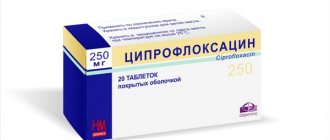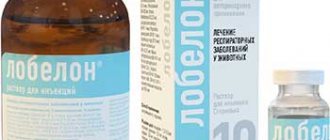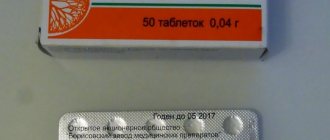Ivermec is a controversial antiparasitic drug. Some dog owners praise it as the most effective treatment for ticks, while others report many side effects, including deaths.
Both are right: the drug copes well with parasitic infestations, but at the same time, it is toxic.
From the article you will learn: how dangerous Ivermek is for animals and people, when it should be prescribed, and in which cases it is better to prefer safer drugs, how to use the medication and which breeds it is strictly prohibited.
At the end of the review you will find analogues, tips on use and preventing negative reactions.
The information is current as of January 2021 and is constantly updated.
Release form and composition
Ivermek for dogs (Ivermek) is a Russian-made antiparasitic agent. It is produced by Russian.
The main active ingredient of Ivermec is ivermectin. The drug is produced in 3 forms: solution, spray and gel.
The solution is produced in 2 variations: the usual one for intramuscular injections and Ivermek ON for treatment from a sprayer. It is usually prescribed to farm animals. It is rarely used for dogs, but sometimes they give injections with medication or drink it.
The components and their content in each form of the drug are different.
| Solution | Spray | Gel |
| Ivermectin (10 mg/1 ml) | Ivermectin (2.5 mg/1 ml) | Ivermectin (1.0 mg/1 ml) |
| Vitamin E (40 mg/1 ml) | Lidocaine (20 mg/1 ml) | Lidocaine (50 mg/1 ml) |
| Excipients | Chlorhexidine (0.5 mg/1 ml) | Panthenol (15 mg/1 ml) |
| Dexpanthenol (10 mg/1 ml) | Excipients | |
| Additional components |
A 30 ml tube of gel costs on average 430 rubles, a spray bottle of the same volume costs 380 rubles. Price for 50 ml of solution – 260 rubles.
We recommend reading our review of 20 drops against fleas and ticks at the link.
Description of the veterinary drug
The veterinary drug is obtained by fermentation of the fungus Streptomyces avermitilis. Contains vitamin E, ivermectin. Ivermek is produced in the form of a sterile, colorless, light yellow opalescent injection solution, packaged in hermetically sealed glass bottles of 1, 10, 20, 50, 100, 500 ml. Each bottle indicates the series, manufacturer, date of manufacture, expiration date, volume, method of use, the inscriptions “For animals”, “Sterile”, the active ingredients and their proportions are indicated. The boxes must contain instructions for use.
Ivermek for animals
One ml of Ivermec contains 10 mg of ivermectin, 40 mg of vitamin E. The unique water-dispersed form ensures a high degree of effectiveness of the veterinary drug.
Ivermek is stored in closed packaging out of the reach of children at a temperature of 0 to 25 degrees Celsius. If stored correctly, the shelf life of the veterinary drug from the date of release is two years. After opening the bottle, Ivermek should be used within 24 hours. After the expiration date, the medication must be disposed of.
Ivermek belongs to the group of moderately dangerous pharmacological drugs. Before use, consult your veterinarian, carefully read the instructions, and strictly adhere to the recommended dosages. When working with veterinary medicine, follow the rules of asepsis.
How it works
The main effect of all forms of release is due to the presence of ivermectin. This substance affects the flow of chlorine ions through the membranes of muscle and nerve cells of parasites. As a result of changes in its value, nerve impulses are disrupted and paralysis occurs, which leads to death.
The remaining effects of the release forms differ depending on the additional components:
- Vitamin E in solution promotes rapid absorption and distribution of the medicine in the tissues and organs of dogs. This is the only variety of Ivermek that acts from the inside.
- In addition to the antiparasitic effect, the spray has analgesic (due to lidocaine), wound healing (due to panthenol) and antibacterial properties (due to chlorhexidine). It is almost not absorbed into the systemic bloodstream and accumulates in the sebaceous glands and hair follicles. Valid for up to 7 days.
- Additional properties of the gel are local anesthetic and antipruritic (due to the presence of lidocaine), as well as reparative (due to panthenol). It acts externally, penetrates the hair follicles and sebaceous glands, where it persists for 5-7 days.
Biochemical, pharmacological properties
Ivermek is a complex drug with a systemic effect. Provides a rapid therapeutic effect when administered intramuscularly in small doses. Contains the most active isomers of avermectins. Vitamin E has an antioxidant effect, so the veterinary drug is low-toxic and absolutely safe for goats, sheep, cattle, small livestock, and pets (cats, dogs). Can be used for preventive treatments, treatment of rabbits, horses, pigs.
The good thing about the drug is that after administration it is quickly absorbed from the injection site, spreads through the bloodstream, evenly distributed in tissues and internal organs. Ivermek for animals is easy to use.
Ivermectin 1% has a pronounced antiparasitic effect. Destroys internal parasites (nematodes, cestodes), which are localized in the gastrointestinal tract, lungs, heart, liver of cattle (cows, calves), other warm-blooded animals, at all stages of their development. In addition, the antiparasitic agent can be used in the fight against ectoparasites - fleas, sarcoptic mites, lice eaters, mosquitoes, and gadflies.
The active components of Ivermek initiate the production of the inhibitory neurotransmitter - gamma-aminobutyric acid, which leads to disruption of the transmission of nerve impulses, provokes paralysis, and causes the death of ecto- and endoparasites.
The veterinary drug is excreted from the body with urine and bile secretions, and in lactating females - also with milk. Before using the product, we recommend that you carefully read the instructions for it.
It is very important to follow the doses prescribed by your veterinarian, which are selected individually for a specific animal species.
Instructions for use and dosage
Features of use in veterinary medicine, the course of treatment and dosage for different forms of the drug differ.
Solution
The solution is prepared and administered only by a veterinarian. Dosage – 0.2 ml of medication per 10 kg of animal weight, the measured amount is diluted in 10 times the volume of water for injection. The injection is given once, and hepatoprotectors are simultaneously administered to maintain liver function. If it is not possible to completely get rid of the mites, the drugs are re-administered after 5-7 days.
Spray
The spray is applied to the skin, previously cleaned of scabs, crusts and dirt. Use the dispenser attachment attached to the bottle. Dosage – 0.2 ml per 1 kg (with one click on the nozzle, 0.125 ml of solution is sprayed).
For mild to moderate lesions, treat the dog 4-5 times, maintaining an interval of 3-5 days between each application. For extensive and severe diseases caused by ticks, the spray is used twice with a break of 1 day. The areas around the eyes and nose are not irrigated, but moistened with your fingers after wearing gloves.
Gel
For skin lesions, the gel is applied to the previously cleansed dermis in a thin layer at the rate of 0.2-0.3 ml per 1 kg. In addition to problem areas, 1-2 cm of healthy epidermis is captured.
For minor injuries, the pet is treated on average 2-4 times, maximum 6 times. Maintain breaks between use of the drug for 5-7 days. If the lesions are extensive, apply the gel twice with an interval of 1 day.
For otodectosis (ear scabies), the gel is placed in clean ears - 0.5-2 ml in each. Afterwards, the auricle is bent in half and massaged for better distribution of the medication. Treat a maximum of 2 times with a break of 5-7 days.
After spraying the solution or applying the gel, a medical collar is put on the dog, which is removed when the drug is completely dry - after 15-20 minutes. Do not bathe your pet for two days, otherwise the effect of the medicine will decrease.
Contraindications and side effects
Ivermec is a relatively harmful substance. Thus, the solution belongs to moderately dangerous drugs (hazard class 3 according to GOST 12.1.007-76), and the gel and spray belong to moderately dangerous medications (class 4). But keep in mind that the main active ingredient ivermectin is classified as extremely dangerous (class 1).
If the dosage is followed, side effects are rare. Still possible:
- allergic reactions;
- hypersalivation (increased salivation);
- excessive tearing;
- frequent urge to urinate and defecate;
- muscle motility disorders.
In case of overdose the following appear:
- muscle tremors;
- apathy;
- profuse hypersalivation;
- lack of appetite;
- diarrhea and vomiting.
Common side effects usually go away on their own without treatment. If the dog was treated with gel or spray, they are removed with a damp cotton swab. Signs of overdose are treated with symptomatic medications.
The medication is prohibited from use:
- sick and exhausted pets;
- pregnant and lactating bitches;
- simultaneously with other acaricidal agents or drugs containing macrocyclic lactones
- puppies up to 3 months;
- near fish and bees due to the toxicity of ivermectin to them.
Operating principle
Ivermectin, which is the main active ingredient of Ivermec of any modification, enhances the production of gamma-aminobutyric acid (inhibition regulator) in the parasite's body . This leads to disruption of the functioning of nerve and muscle tissue, which subsequently leads to paralysis and death. Panthenol relieves irritation and inflammation of affected areas on the animal’s body and helps accelerate the regeneration process. Lidocaine has an analgesic effect . Chlorhexidine is used in the vaccine as an antibacterial agent.
Ivermek's action lasts up to 14 days , which allows you to destroy parasites at any phase of their maturation. Gel and spray only affect external parasites .
Ivermek is a low-hazard drug for warm-blooded animals, but has a toxic effect on bees and fish.
Analogues of the drug
Please read this section carefully!
There are a dozen analogues of Ivermek: Iversect, Ivomek, Novomek, Noromektin, Baymek, Ivermag, Ganamektin, etc. But all these drugs are produced in the form of injection solutions and are used for farm animals: cows, pigs, sheep, goats, deer, horses, camels .
Sometimes the veterinarian can prescribe these synonymous drugs for dogs. But such a prescription is resorted to as a last resort: with stable generalized demodicosis, which cannot be treated with safer drugs. In these cases, 1-4 injections are given with an interval of 5-7 days, and at the same time agents are used to support the liver. Remember that this is a last resort: therapy with ivermectin-based medications is carried out only as prescribed and under the supervision of a physician.
Ivermec is one of the few drugs containing ivermectin that can be used independently in pets. Other similar drugs:
| Analogue drug | Differences | average price |
| Acaromectin | The only synonym of Ivermec based on ivermectin, which is used in pets. For dogs it comes in one form - a spray. Does not contain excipients that relieve symptoms: lidocaine, panthenol, chlorhexidine. | 180 rub. per 25 ml bottle. |
| Aversect K&S | Medicine based on aversectin. Produced in the form of an injection solution. | 90 rub. for 5 ml. |
| Aversectin ointment | A means for external treatment based on the aversectin complex. A safer device, but less effective. | 75 rub. for 15 years |
Review of 17 anthelmintics for dogs.
Indications for use
The drug is effective against mature and larval stages of nematodes of the gastrointestinal tract, lung and heartworms, as well as against attacks by external insects: ticks, lice, gadflies.
In cattle it is prescribed for strongyloidiasis, psoroptosis, neoascariasis of calves, sarcoptic mange, hypodermatosis, chorioptosis.
For small cattle with hemonchosis, dictyocaulosis, habertiosis, bunostomiasis, marshallagiasis, estrosis, strongyloidiasis, dictyocaulosis, malophagosis, psoroptosis.
Ivermek (solution for injection)
For pigs, we can use the drug for esophagostomiasis, metastrongylosis, stephanurosis, hematopinosis, strongyloidiasis, sarcoptic mange.
It is prescribed for horses for oxyurosis, gastrophylosis, strongyliasis, parascariasis, sarcoptic mange.
For rabbits it is used for nematodes and sarcoptoid mites, but with caution due to dosage. For cats and dogs it is indicated for toxascariasis and toxocariasis, hookworm, notoedrosis, uncinariasis, sarcoptic mange, demodicosis, fleas, lice, lice
For cats and dogs it is indicated for toxascariasis and toxocariasis, hookworm, notoedrosis, uncinariasis, sarcoptic mange, demodicosis, fleas, lice, lice.
Owner reviews
Irina: “With the onset of spring, the dog developed small bald spots and itching. Until the fall, various veterinarians could not cope with the problem: they healed it so that scratches were everywhere: on the paws, sides, and groin. Only months later we found a good dermatologist who prescribed Ivermek: the drug helped after 3 weeks.”
Iraida: “My 6-year-old chow-chow began to lose hair, then scratching appeared. The doctor diagnosed demodicosis and prescribed Ivermek injections. Every week I took the dog to the clinic: the vet gave injections every 7 days. After just 2 uses, new scratches stopped appearing and the hair began to grow back. The medicine is good, but you need to choose the right dosage and course of treatment: I myself would not use such a toxic drug.”
Answers to frequently asked questions
Is it possible to buy and use Ivermek yourself?
All available forms of the drug are sold without a prescription. However, it is toxic, so it is used only as directed and under the supervision of a veterinarian. This is especially true for the injection solution: improper administration or overdose often led to the death of animals.
Is Ivermek allowed to use collies?
No. Ivermectin in the medication is dangerous for collies and their mixed breeds. This substance is also toxic to Shelties, Bobtails, Welsh Corgis, Greyhounds, Bull Terriers, Doberman Pinschers and Shar-Peis. Administration of Ivermec to these breeds and their crosses causes serious complications with possible death within 15 minutes of use.
How harmful is Ivermec for people? Is it dangerous for children?
The drug is moderately toxic. When using it, it is important to follow general safety precautions: during use, do not drink, eat or smoke, handle the animal with gloves, and then wash your hands with soap. If the drug accidentally gets on the mucous membranes or in the eyes, they should be rinsed with running clean water. In case of accidental ingestion, contact the clinic immediately, taking the instructions with you.
After the dog has been treated, it should not be petted or allowed near children for 2 days. In case of accidental contact, wash hands thoroughly.











